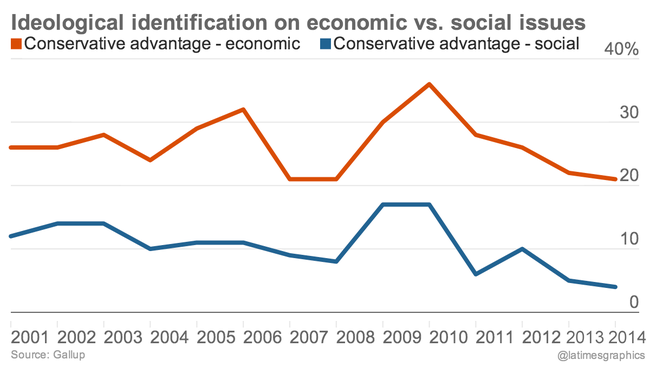Conservative tide continues to ebb, particularly on social issues
David Lauter

Conservatives have long outnumbered liberals, but the left is catching up, new Gallup polling shows
A waning conservative advantage could pose problems for Republicans in future elections
On social issues, roughly equal numbers of Americans identify as liberals and conservatives, Gallup finds
Self-professed conservatives have long outnumbered liberals in America, but the gap has narrowed significantly in the last four years, particularly on social issues, a shift that could harm GOP prospects in future elections.
On social issues, the number of people who identify themselves as liberal is now almost equal to the share who say they are conservative, according to the latest polling by Gallup. For years, conservatives held an advantage.
About one-third of Americans identify with either group. Another third call themselves moderates on social issues. As recently as 2010, conservatives had a 17-point advantage over liberals on social issues in Gallup’s polling.
A similar shift has taken place on economic issues, although the conservative advantage remains bigger in that realm.
Just as a rising conservative tide helped Republicans in 2010, a waning one -- if it continues – could pose problems for the party in future elections. Republican strategists already worry about the gap separating the party from black, Latino and Asian American voters, and an ideological gap would add to their burden.
Conservative lead on social and economic ideology shrinking
Figures are the percentage identifying as conservative minus the percentage identifying as liberal
Measuring how people identify themselves ideologically doesn’t necessarily reveal how they will vote on specific issues or candidates. Many Americans do not have consistent ideologies. Moreover, a person who identifies as a moderate in a place like California might easily be considered liberal in Texas. But the shift in how Americans identify themselves on social issues has coincided with stronger support for liberal positions on issues including same-sex marriage, the death penalty and legalized marijuana.
Moreover, shifts in ideological identification do provide some clues to voting patterns. Typically, the public becomes more liberal when conservatives hold power and more conservative under liberal administrations – seemingly reacting against the perceived excesses of whichever party holds power.
cComments
@knox.bob.xpg No question we have a "very divisive government." But we also have a very divisive media, a very divisive society, a very divisive culture. So which comes first, the chicken or the egg?
surf city rod
at 5:58 PM May 30, 2014
Add a comment See all comments
54
That tendency proved dramatically true after President Obama’s election, when a conservative flood began to gather in 2009 and peaked in 2010.
Since then, however, the tide has ebbed. The conservative edge on social issues, 4 percentage points, is the smallest Gallup has measured in the 14 years it has tracked American ideologies. On economic issues, the gap was significant, with conservatives at 42% to 21% for liberals, with 34% calling themselves moderate. But the conservative advantage has narrowed from 36 percentage points in 2010 to the current 21 points, matching the narrowest previous gap, in 2007 and 2008, when Obama first won the presidency.
Related story: Republicans poised for midterm gains, polling indicates
Related story: Republicans poised for midterm gains, polling indicates
David Lauter
Public opinion has not moved across the board. On social issues, the Republican identification as conservative has held steady while Democrats have become more likely to call themselves liberal.
On economic issues, the two parties have moved away from each other. Republicans and independents who lean toward the GOP are far more likely to call themselves conservative now than they were a decade ago. Among Democrats and Democratic-leaning independents, the largest share identify as moderates on economic issues, but the share who call themselves liberal has grown from about one-quarter a decade ago to more than one-third now.
The findings underscore earlier polling suggesting the country is more polarized than in the past.